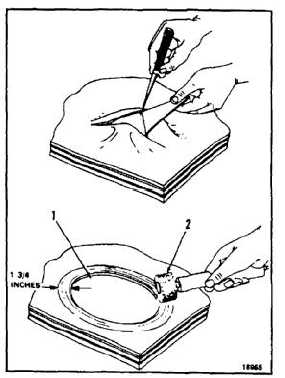TM 55-1520-240-23-8
10-15
REPAIR FUEL CELL INNER LINER
10-15
INITIAL SETUP
Applicable Configurations:
All
Tools:
Portable Drill, Pneumatic, NSN 5130-00-293-1978
Abrasive Arbor, 1/4 Drive, 1 Inch Diameter, 1 Inch
Long, Dunmore Model R421003 or Equivalent
Materials:
Cloth (E120)
Methyl-Ethyl-Ketone (E244)
Barrier Cement (E63.3)
Repair Cement — 2 Part Set (E63.2)
Gloves (E184.1 and E186)
Wooden Tongue Depressor (E424)
Scotch-Brite (E2)
Personnel Required:
Aircraft Structural Repairer
Inspector
References:
None
Equipment Condition:
As Required
General Safety Instructions:
Methyl-ethyl-ketone (E244) and
barrier cement (E63.3), repair cement
(E63.2) and its components are
flammable and toxic. They can irritate
skin and cause burns. Use only with
adequate ventilation, away from heat
or open flame. Avoid contact with skin,
eyes, or clothing. In case of contact,
immediately flush skin edges. or eyes
with water for at least 15 minutes.
Get medical attention for eyes.
1.
Repair blisters, cuts, tears, snags and abrasions
that damage but do not penetrate the inner
reinforcement plies (No Fabric Damage) as
follows.
a.
Clean damaged area using a clean cloth
dampened with MEK (E244). Wear gloves
(E184.1).
a.1.
Trim away loose, damaged or blistered edges.
b.
Buff surface around damage (1) 1-3/4 inches
larger in all directions than damaged area.
Use portable drill (2), abrasive arbor, and/or
scotch-brite (E-2). Buff only to remove gloss
without excessively reducing inner layer
thickness.
c.
Clean buffed area. Use a clean cloth (E120)
dampened with MEK (E244). Wear gloves
(E184.1).
d.
Prepare repair cement (E63.2) by blending
the two ingredients of part 2 (E63.5) together
first and then transfer the entire contents of
part 2 into the can of part 1 (E63.4). Wear
gloves (E186).
10-57

